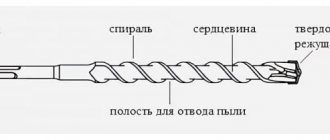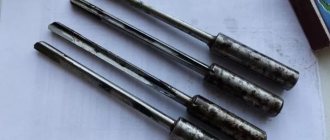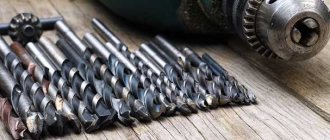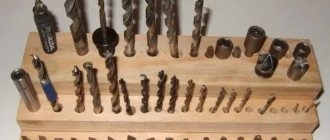To create holes in particularly strong materials, you must use concrete drills specially designed for this purpose. When using other types, the cutting zone becomes unusable and becomes dull. Before you start working, you need to familiarize yourself with the types of concrete drill bits for drills, which ones are better, how to choose tools and what is the best way to drill.
What is different about a concrete drill?
It has a special brazing made of a reliable alloy with a hardness level comparable to diamond. We are talking about victorious coating.
Equipment for drilling element for concrete:
- Can be used in conjunction with a drill. The design of the drill is distinguished by the presence of a tail with a cylindrical or multifaceted shape;
- For a hammer drill. It is made in a shape similar to a shank or cylinder. For marking, the inscription SDS PLUS or SDS MAX is used.
How to drill through reinforced concrete?
If you use an impact drill model for concrete based on reinforced concrete, then nothing will work. To do this, you will have to use a hammer drill with a special type of impact drill for concrete; it is also called a drill for this dense material.
Special drill for reinforced concrete:
- Screw type. They help create holes with increased depth;
- Twist drills. Help create large holes;
- Gentle views. Suitable for creating holes with a small diameter and shallow depth.
To use such drills based on an impact drill or hammer drill, you need to fix them in the drive part of the chuck.
To facilitate installation, the drill design has a thickening at the tip. We are talking about professional equipment. It allows you to create holes with a diameter of around 4 mm and up to 3 cm.
About the design of shanks
The types of nozzles under consideration are classified into two main types according to the shape of the shank:
- Cylindrical - these are the most common, and are designed directly for impact drills with collet keys or keyless chucks
- Hexagonal shapes - this shank on concrete drills has an identical design with bits for screwing and unscrewing fasteners. Such nozzles with hexagonal shanks have a diameter of no more than 8-10 mm, and why this is so, we will consider further
When drilling concrete, and especially reinforced concrete, the drill may stall (get stuck). Due to the special cylindrical design of the shank, when it jams, the nozzle rotates, eliminating overheating of the motor and licking of the gear teeth. When using drills with hexagonal shanks in a collet chuck, the possibility of them turning when jammed is eliminated. As a result of getting stuck, not only the tool, but also the person can suffer. This is why manufacturers do not produce concrete drills with a hexagonal shank for drills larger than 8-10 mm.
This is interesting!
Drills with hexagonal shanks can also be used in the design of screwdrivers, where the chucks have a special hexagonal shape of the landing splines. There are also devices with tapered shanks that are designed for drilling machines, but they are not suitable for drilling into walls.
Using a crown on concrete
If a particularly large hole with a large diameter is required, then the use of a core tool for working with concrete is beneficial. This device will help create a recess based on a diameter of 12 cm in high-strength materials.
Core drill options:
- Diamond modification. Outwardly it looks like a tube or crown fixed to a rod. Diamond coating has been added to the edges;
- Pobedit version. Manufactured as a nozzle. It has an identical structure. But instead of diamond coating, pobedite teeth are used.
A core drill for concrete is used when it is necessary to prepare a recess for mounting an outlet or switch.
Important: To select the right device and drill for working with reinforced concrete, it is necessary to take into account the density of the material and the required size, depth, width of the hole.
The diameter of the drill in the end may be around 4 - 12 mm or more with a length from 50 mm to 1,000 mm. Therefore, it is clear that to create a large hole, larger and longer drills are required for working with reinforced concrete.
What to consider when buying a pobedit drill bit for a drill
For concrete, drills for power tools such as drills can be purchased in a set. This will allow you to use a nozzle of the required diameter if necessary. It is the diameter that must be taken into account before buying a drill.
When choosing a diameter, you need to take into account that drills for concrete indicate the size of the cylindrical part. When making a hole, the hole expands due to special plates on the head of the nozzle, which have a slight protrusion of up to 1 mm. That is why, if it is necessary to recess a dowel measuring 6 mm in a hole, then for drilling you will need equipment measuring 5 mm. This must be taken into account at the stage of choosing a nozzle. If a hole of large diameter is drilled and the dowel does not hold in it and is recessed, then there are special sealing devices for this.
In addition, the nozzles in question come in different lengths, which allows you to make holes of the appropriate depth. When purchasing, you must also consider the manufacturer. Often cheap drills are made by little-known or not at all well-known companies. Not always, but often such cheap concrete drills quickly fail. The cutting edge on them becomes dull, and therefore the equipment subsequently fails to cope with its task.
If you need to purchase high-quality equipment for a drill, then you should choose models from such well-known manufacturers as Bosch, Makita, Metabo and others. If you are drilling brick, ceramics or reinforced concrete, then for such work it is better to use drills with diamond coating on the head. Diamond types of equipment are considered the best in relation to drilling high-strength materials. In addition, depending on the quality of the equipment, they work for quite a long time.
This is interesting!
The only big disadvantage of diamond-coated concrete drills is the price. The price, compared to Pobedit ones, differs by more than 2 times, so you need to think about the rationality of such an acquisition in advance.
How to choose a drill for concrete?
For example, a drill based on an impact drill can penetrate lightweight types of concrete: aerated concrete, foam concrete, expanded clay concrete. But there is a very important nuance. The model of the selected equipment must have the “impact drilling” function.
Thanks to this, it is possible to create holes in the considered type of solid material and the average level of concrete.
- But, if you need to create a hole in beams, columns, or tiled floors, such equipment will not be suitable, since in this case reinforcement is used on the inside of the material.
- To cope with this task, it is worth studying the capabilities of various hammer drills equipped with the appropriate drill. The problem is that a standard drill will not be able to provide the impact force to work with such material.
These points must be taken into account when choosing a device and drill to perform the job reliably.
Step by step drilling process
Let's look at how to drill a brick wall with a regular drill. But the latter must have a striking mechanism. Because without it, the tool will quickly begin to overheat. And this is extremely undesirable, since it will lead to rapid wear.
The power of the drill must be at least 600 W. And the rotation speed of the drill is above two thousand revolutions per minute. It is believed that the higher this number, the better. This is partly true. But professionals prioritize a tool that has smooth speed control.
Before drilling, you need to make sure that the process will not disrupt any communications, such as electrical wiring or water pipes. If there is no paper plan for the location of the latter, then you need to use a portable metal detector. The device is able to indicate any iron that is located no deeper than one centimeter from the surface.
Household metal detector Source arrows.ru
Detailed instructions on how to drill through a brick wall:
- Markings are applied to the surface.
- By hitting the center punch at the desired point, a depression is made, which will help fix the drill in a level position.
- The tip of the nozzle is installed in the intended location.
- Holding the drill strictly straight, turn on low speeds to start working.
- Smoothly pressing on the tool, gradually increase the speed, gradually bringing it to maximum.
- The process is periodically interrupted to cool the cutting part of the drill.
- The operation is carried out either until the tip of the nozzle exits the other side of the wall, or until the desired depth of the hole is reached.
Throughout the process, it is necessary to control the position of the drill. Its displacement from the perpendicular can lead to breakage of the drill. And if it is necessary to make a through hole, then a tool of sufficient length is selected.
Recommendations for working with concrete
A quality choice of equipment and drill does not guarantee a positive result. You must be able to use the selected device correctly.
Helpful Tips:
- Before starting work, you should prepare the device and a set of drilling elements. It is important to realize that creating a hole with the required diameter requires the appropriate drill and equipment. Therefore, it is necessary to have different models to solve any problem;
- If during operation the drill hits the reinforcement, then it is beneficial to change the drill to a model for drilling metal. But this problem can be solved by pre-sharpening the drill. This way you don’t have to interrupt work to replace the drilling element;
- During operation, it is important to prevent the drill from overheating. Therefore, you should take a short break every 15 seconds. But for this you should use the natural cooling process. There is no need to pour water or other liquid over the drill, as it may become damaged;
- In the case of a meeting with a very hard stone, it is beneficial to have a chipper in your arsenal. It will help crush the obstacle to make room for the drill to work;
- It is not recommended to use an impact drill on a load-bearing wall or ceiling. It will not help in creating a hole with the required diameter and depth. In this case, it is more profitable to use a hammer drill;
- If you are making a hole in ceramics, then you should also use equipment for concrete. But with one difference, you need to turn off the shock mode, this will help maintain the integrity of the tile;
- If during operation the drill has noticeably deteriorated or become dull, then to restore factory characteristics it can be processed with a grinder in combination with a diamond disc. But when using an expensive and high-quality drill, such situations usually do not occur. Therefore, it is profitable to purchase professional equipment. It is more expensive, but there are fewer unexpected problems with it.
Now we understand how a drill for working with concrete differs and what equipment it is used with. We understood the advantages of a core drill for this hard material.
We looked at the aspects that need to be paid attention to in the process of choosing a drill and the corresponding device. To simplify the work process, many useful tips have been offered. Therefore, now we have enough information to create a hole based on this material.
Advantage
- Diamond drills allow you to process materials of any hardness and strength with equal efficiency.
- High Precision – The diamond edge produces a very fine cut, allowing for extreme precision.
- Reduced energy costs - the crown cuts out the core rather than converting it into chips. As a result, working with a diamond drill will require less time and much less power.
- Drilling of concrete and reinforced concrete structures occurs using a non-impact method, which also reduces energy consumption.
- There is no dead center in , so there is no need for pre-drilling.
- When drilling, less dust is generated, and accordingly, the noise level is also significantly lower.
vote
Article rating











